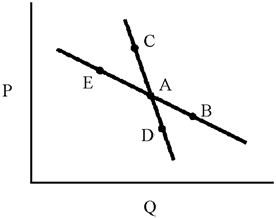A) Joan Robinson and Edward Chamberlin.
B) Adam Smith and David Ricardo.
C) Alfred Marshall and Francis Edgeworth.
D) Wassily Leontief and Joseph Schumpeter.
Correct Answer

verified
Correct Answer
verified
True/False
In the long run, a monopolistically competitive firm produces at minimum average cost.
Correct Answer

verified
Correct Answer
verified
True/False
A monopolistic competitor can expect to earn an economic profit in the long run.
Correct Answer

verified
Correct Answer
verified
True/False
Sticky prices are a direct result of the kinked demand curve.
Correct Answer

verified
Correct Answer
verified
Multiple Choice
The contestable market theory best applies to
A) pure monopoly.
B) oligopoly.
C) monopolistic competition.
D) perfect competition.
Correct Answer

verified
Correct Answer
verified
True/False
The demand curve for a monopolistic competitor is likely to be steeper than that of a monopolist.
Correct Answer

verified
Correct Answer
verified
Multiple Choice
Figure 13-1
 In Figure 13-1, for a monopolistically competitive firm, long-run equilibrium can occur only at the quantity indicated by which point?
In Figure 13-1, for a monopolistically competitive firm, long-run equilibrium can occur only at the quantity indicated by which point?
A) A
B) B
C) C
D) D
Correct Answer

verified
Correct Answer
verified
True/False
A cartel is a group of sellers of a single product who have joined together in order to enjoy the advantages of perfect competition.
Correct Answer

verified
Correct Answer
verified
Multiple Choice
The analysis of oligopolistic behavior is difficult because
A) there are few real-world examples of oligopolies for economists to study.
B) oligopolists make decisions independently of each other.
C) firms in oligopolistic industries react to each other's behavior in many ways.
D) economists have paid little attention to the topic in recent years and so have not yet applied to it the techniques of modern economic theory.
Correct Answer

verified
Correct Answer
verified
Multiple Choice
Figure 13-3
 Oligopolist A cuts price in an attempt to enlarge his share of the market. His competitors retaliate with identical price cuts. In this case, in Figure 13-3, oligopolist A will move from point A to which point?
Oligopolist A cuts price in an attempt to enlarge his share of the market. His competitors retaliate with identical price cuts. In this case, in Figure 13-3, oligopolist A will move from point A to which point?
A) B
B) C
C) D
D) E
Correct Answer

verified
Correct Answer
verified
Multiple Choice
In Figure 13-3, according to economic theory, the kink in the demand curve will occur at point
A) E.
B) A.
C) C.
D) D.
Correct Answer

verified
Correct Answer
verified
Multiple Choice
Monopolistic competition is different from perfect competition in that every manufacturer
A) has a small monopoly, and differentiates the product.
B) takes the product quality as given, and chooses price.
C) takes output level as given, but must choose price.
D) differentiates product, but cannot advertise successfully.
Correct Answer

verified
Correct Answer
verified
Multiple Choice
All of the following are possible characteristics of oligopoly except
A) free entry into the industry.
B) significant economies of scale.
C) interdependence among sellers.
D) homogeneous product.
Correct Answer

verified
Correct Answer
verified
True/False
Game theory is based on the idea that each participant makes decisions based on how she believes the competition will react.
Correct Answer

verified
Correct Answer
verified
Multiple Choice
The apparent stickiness of the price of goods sold by oligopolists can be explained by the
A) contestable markets model.
B) sales maximization model.
C) kinked demand curve model.
D) entry deterrence model.
Correct Answer

verified
Correct Answer
verified
True/False
Monopolies can misallocate resources by restricting output in an attempt to raise prices and profits.
Correct Answer

verified
Correct Answer
verified
Multiple Choice
Which of the following is an example of tacit collusion?
A) OPEC
B) Copper cartel
C) Price leadership
D) Government franchise granted to a utility
Correct Answer

verified
Correct Answer
verified
True/False
Repeated games can lead to tacit collusion.
Correct Answer

verified
Correct Answer
verified
True/False
Unlike the situation for a firm in perfect competition, positive economic profit exists for firms in monopolistic competition for both the short run and in the long run.
Correct Answer

verified
Correct Answer
verified
True/False
Monopolistically competitive markets feature high barriers to entry.
Correct Answer

verified
Correct Answer
verified
Showing 21 - 40 of 254
Related Exams